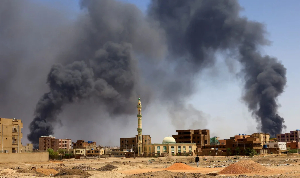From the Agbadza dance to Bird Dance ("Vogeltanz") through to the recent Gangnam Style biodiversity reinvents its meaning in our society. As the African cup of nations rolls into full swing, you can see animals leading the charge of national teams. Angola is Palancas Negras (The Black Antelopes);Cote d'Ivoire - Les Éléphants (The Elephants); Mali - Les Aigles (The Eagles);Nigeria - The Super Eagles;Tunisia - Les Aigles de Carthage (The Eagles of Carthage). The earth’s biological resources are critical to humanity’s economic and social development. Biodiversity is a universal resource which is invaluable for both the present generation and posterity although the scale of current threats to species and ecosystems is unparalleled and calls for urgent action (CBD, 2012).
Biodiversity is a key component of a healthy environment and offers the foundation for ecosystems and the services they supply to sustain life on earth (UNEP 2005). Through the tangible (eg food) and intangible (eg decomposition) services of biodiversity, peoples’ livelihoods are intricately dependent on it. Poor people often are at the mercy of ecosystem degradation as they are at the brunt of such changes due to their reliance on ecosystem services and residing in locations most vulnerable to ecosystem fluctuations (UNEP, 2005).
Global consensus is vital to safeguarding biodiversity and consequently ensuring environmental sustainability. Global frameworks such as the Convention on Biological Diversity (CBD); the Natura 2000 Network which involves the Birds Directive in 1979 and Habitats Directive in 1992 of the European Union, echo the need for international cooperation in safeguarding natural processes, species migrations and consequently halting and reversing biodiversity loss (EU 2012). Furthermore, the Millennium Development Goals (MDGs) have come to emphasize the essence of biodiversity to ensuring environmental sustainability for the benefit of man’s continuous survival on the planet and the maintenance of the global economy (UN 2010). However as 2015 approaches, it has become urgent to intensify efforts and adopt more robust approaches to ensure that the principles of sustainable development take centre stage in national policies and programmes to preserve the biological integrity of environmental resources (UN 2010). Given the interdependent nature of the MDG’s; ensuring environmental sustainability of which biodiversity is an integral component, will have positive spin offs on other goals for the benefit of human society (UN 2010). Migrant animals are vital elements of the earth’s biodiversity offering essential services to the functioning of ecosystems e.g. as pollinating and seed dispersal agents, as supply source in the food chain for other animals etc. Migratory Species form a key component of biodiversity. Migratory species are “the entire population or any geographically separate part of the population of any species or lower taxon of wild animals, a significant proportion of whose members cyclically and 19 predictably cross one or more national jurisdictional boundaries”’ (Convention on Migratory Species Text ,1979).
Via the media of air, land and water, thousands of species and millions of animals criss- cross the globe in a web of prehistoric migratory pathways based on their affiliation to locations and passageways worldwide). Furthermore, the destruction of even a minute section of the migration path can endanger the total population, while their en masse gathering makes them prone to overharvesting and poaching (CMS, 2011).
Aside their innate value migratory species offer several socio-economic cum cultural services to communities and ecosystems (UNEP/CMS). As key elements of biodiversity, the World Commission of Environment and Development (Brundtland Commission) warns that their uncontrolled loss limits the range of development options in the future (UNEP,1999). Migratory animals are also uniquely outstanding by virtue of their predictable long journeys. These species affect the continued existence of non-migratory species and individual societies which depend on the usual arrival of these migratory species. Several Migrant animals serve as the basis for ‘subsistence, recreational and commercial hunting and fishing activities, often serving as an important basis for the livelihoods of local communities’ (CMS, 2005). Furthermore, due to their migrant characteristics they symbolize a shared, resource which varies over seasons for human communities separately distant. Consequently the usage of this unique resource by one community may determine its availability or accessibility to persons in a different, usually far-off, location. Across the globe, the predictable arrival and departure of migrant fauna are a potent symbolism of the different phases of nature’s seasons of nature and the transitions of annual cycles. Migrant animals have enhanced the cultural integrity of human communities with their invaluable importance cutting across varied aspects of human life - in mythology, tales, faith/religion and medicine (UNEP,1999). The eagle is seen as an animal representing self-confidence, scholarly freedom, and pursuance of eccentric ideas. It epitomizes freedom with responsibility as is for example in the national symbols of several countries. Amongst Freemasons, the ‘double headed eagle stands for the 33rd Degree of the Scottish Rite’( Great dreams.com,2012). However, the elephant – symbolizes life lifetime memories, as well as charitable and sociable nature. Its image connotes strength and intelligence. In Buddhism, a white elephant proclaimed the nativity of Gautama Buddha. In Hinduism , the god of wisdom Ganesha is depicted with a tusked elephant head and mounts a mouse. The elephant is also a principal attendant for the god Shiva. It is an emblem of the triumph of life over death (Great dreams.com,2012). The dove on the other hand symbolizes peace. It represents the Holy Spirit in Christianity– thus upon Jesus’ baptism a dove descended on him (Matthew 3:16). They can be seen soaring from the mouths of dying martyrs. Lion – refers to strong character, military gallantry, immense energy, and dominion. The fifth sign in astrology Leo (July 23 - Aug 23) is represented by a lion with the sun as its planet. People who trace their birth to Leo are seen as born leaders, clever and generous. A myriad of traditional dances mimic migrant animals, the Bird Dance ("Vogeltanz") and the Agbadza dance both imitate birds whilst, the recent Gangnam Style dance of Korean Pop sensation PSY for example mimics a horse and is termed the horse-dance.
The use of animal parts in traditional health care delivery is common in many of the world and in a way contributes to their decline. In contemporary times the impressive arrivals en masse of migratory fauna in relation to certain seasons has evolved into a magnet for eco-tourism/ nature tourism and a lure for nature tourists who would like to watch animals such as birds, turtle or whales. This has boosted the livelihoods and economies of many local communities. Many companies local and multinational also have a penchant for branding their institutions using animal logos based on desired traits to increase the appeal and enhance company profile eg the panda is used by the World Wide Fund for Nature (WWF), the jaguar is the symbol for the Jaguar vehicle, the fox is used by internet service Firefox, the largest airline in Europe, Lufthansa is symbolised by a soaring crane to mention but a few. As the African cup of nations rolls into full swing, you can see animals leading the charge of national teams. Angola is Palancas Negras (The Black Antelopes);Cote d'Ivoire - Les Éléphants (The Elephants); Mali - Les Aigles (The Eagles);Nigeria - The Super Eagles;Tunisia - Les Aigles de Carthage (The Eagles of Carthage).
Many countries also use animals as their national symbols and associate themselves with certain characteristics of such animals. These animals can be seen the national flags and coat of arms. The peculiar characteristics that define migrant species such as requiring varied microhabitats and at different stages of their life cycles present equally peculiar challenges to their conservation.
Submitted by
Felix Kwabena Donkor MSc Environmental Management and Sustainability Sciences Aalborg University Denmark 28th January 2013
Opinions of Thursday, 31 January 2013
Columnist: Donkor, Felix Kwabena














